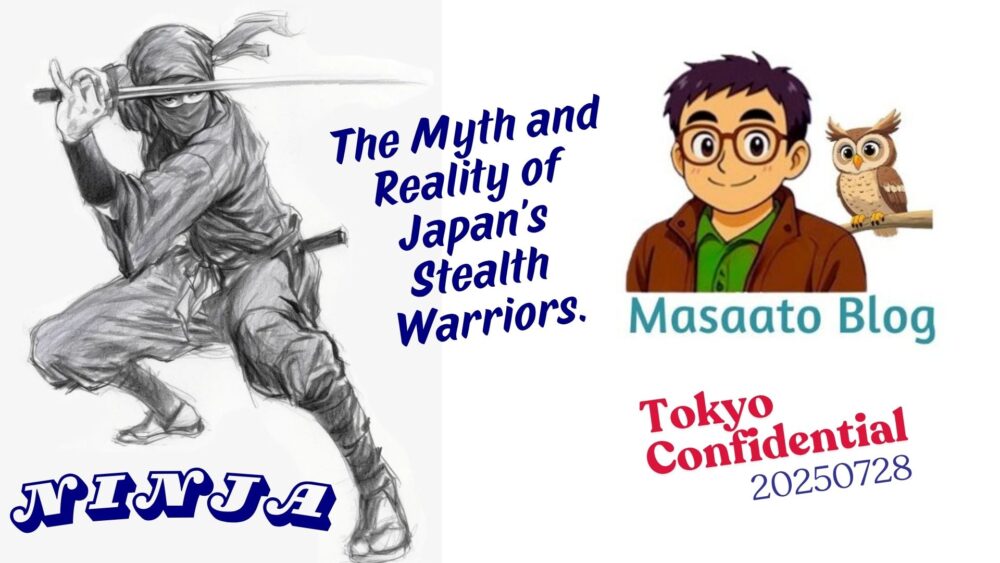Foreign tourists visiting Japan often point out how clean the streets are and how kind and courteous the Japanese people are to everyone.
Such noble aspects of the Japanese spirit were cultivated during the Edo period (1603-1867), which preceded the Meiji Restoration (1868) – the gateway to Japan’s modernization.
The sense of propriety and respect for others found among the samurai class at that time gradually spread not only among warriors but also among farmers, artisans, and townspeople.
Before the Edo period, Japan experienced a time of conflict among samurai groups (1467-1576). It was during this era that a profession known as “ninja” emerged, primarily to gather intelligence on enemies.
These ninjas were not primarily fighters, but rather operatives who obtained information or carried out assassinations of key enemy figures.
The martial arts and tools they developed were primarily designed for self-defense and to ensure their successful escape from potential threats.
This article introduces the basic knowledge about ninja, along with the weapons and techniques they used. We explore the myth and reality of Japan’s stealth warriors
【contents】
- 1. Ninja who?
- 2. History of the Ninja
- 3. Specific Examples of Ninja Activities
- 4. Ninja Attire
- 5. What Are the Two Major Ninja Schools?
- 6. Ninja Weapons
- 7. Ninja Meals
- 8. Methods of Learning Martial Arts and Espionage Techniques
- 9. Ninja Memory Techniques
- 10. Ninja’s Basic Physical Training Methods
- 11. Disguisement
- 12. The Execution Date of a Mission and Sleep
- 13. Five Famous Escape Techniques
- 14. Female Ninja
- 15. Real-Life Ninja in Japan
- 16. Ninja-related facilities
- 16-1. International Ninja Research Center (Mie Prefecture)
- 16-2. The International Ninja Research Association (Mie Prefecture)
- 16-3. Ninja Museum of Igaryu (Mie Prefecture)
- 16-4. Koga Ninja Village (Shiga Prefecture)
- 16-5. Ninja Experience Cafe Tokyo Harajuku
- 16-6. Ninja Trick House in Tokyo
- 16-7. Ninja Weapon Museum (Kanazawa City)
1. Ninja who?
1-1. Who Are the Ninja?
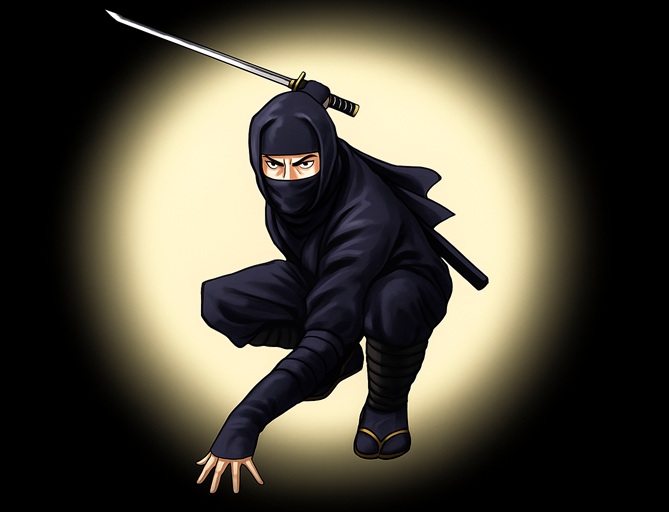
I am a government-certified tour guide. I offer tours of numerous attractions to foreign visitors to Japan, many of whom have thoroughly studied Japanese culture and customs before arriving.
They often have extensive knowledge about sumo, Japan’s national sport, nihonshu (sake), a uniquely Japanese alcoholic beverage, and the Japanese aesthetic principles of wabi and sabi(*).
(*) Wabi and Sabi are traditional Japanese aesthetics that value simplicity and imperfection.
Wabi refers to a quiet, rustic beauty found in simple, humble things.
Sabi is the beauty that comes with age, like weathered wood or a faded kimono.
When it comes to younger travelers, I frequently get questions like:
– “Who are the ninja?”
– “How are ninja different from samurai or warriors?”
– “Where can I meet a ninja?”
– “Were there female ninja?”
Occasionally, travelers even share their knowledge about ninja with me and ask if their information is accurate.
This book is designed to answer these kinds of questions.
By reading it, you can become a “Ninja Scholar” and proudly show off your expertise in front of your friends.
1-2. Historical Background of Japan
Let’s look broadly at Japanese history to understand how ninjas fit into it.
Between 794 and around 1000, the imperial court was located in Kyoto. In 1867, Tokugawa Yoshinobu, the 15th shogun of the Edo Shogunate, returned political power to the imperial court, which then relocated to Edo (modern-day Tokyo).
During this period, several samurai-led governments established the feudal system known as the bakuhan structure to govern Japan.
Ninjas were originally referred to as shinobi during that time. The term “ninja” became popularized in the late 1950s through its use in novels and other media.
Besides shinobi, they were also called rappa, suppa, kusa, dakkou, and kamari, among other names.
It is believed that ninja began their activities around the early Nanboku-cho period (circa 1340). From this time until the end of the Edo period (1603–1867), ninja were active in various capacities.
1-3. The Missions of Ninja
The most important duty of a ninja was to gather intelligence as ordered by their lord. Some ninja did not serve a specific lord and instead acted as mercenaries hired for each battle. Others worked independently.
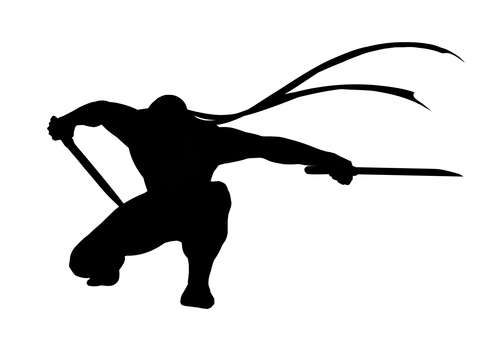
Ninja mastered various techniques of ninjutsu and utilized a wide range of weapons and tools. These skills and equipment were primarily for secretly infiltrating enemy territory, conducting espionage or sabotage, and then escaping undetected. They were not intended for offensive purposes.
Ninja carried out a diverse range of missions, including intelligence gathering and espionage to monitor enemy movements, sabotage to destroy enemy facilities or supply lines, infiltration tactics to collect information from within enemy ranks, deception through strategies and traps to mislead the enemy, and assassinations of key figures.
During the Edo period, an era of peace with no wars, the role of the ninja changed. Many became employed by the shogunate or various domains, taking positions as lower-ranking samurai. Others became farmers with samurai status or simply lived as ordinary farmers.
Ninja who served domains often continued intelligence activities, such as gathering information about neighboring domains or monitoring rumors of peasant uprisings. However, their day-to-day responsibilities often involved duties like guarding castle towns or castles.
Meanwhile, among those ninja who remained in villages, some families sought to preserve the knowledge of ninjutsu for future generations by documenting their techniques in ninja manuals.
2. History of the Ninja
The history of the Japanese ninja is based largely on legends and war chronicles, and its full picture remains unclear. However, it can be broadly summarized as follows:
2-1. Origins around the 12th century
The origins of ninja can be traced back to “onmitsu” (covert activities) that emerged during the late Heian period (794–1185) and the early Kamakura period (1185–1333).
In particular, regions like Iga (present-day Mie Prefecture) and Kōga (present-day Shiga Prefecture) saw practitioners such as yamabushi and jizamurai engage in infiltration, intelligence gathering, and sabotage behind enemy lines. At the time, the term “ninja” was not yet in use—they were instead referred to as shinobi, kanja (spies), or kusa (literally “grass,” indicating hidden agents).
Yamabushi, or ascetic monks, were practitioners of Shugendō, a belief system that combined Japan’s ancient mountain worship with elements of Buddhism and Esoteric Buddhism. They trained in the mountains, developing both spiritual and physical endurance.
Jizamurai were powerful peasants who rose to samurai status during the Muromachi and Sengoku periods (1336–1568). They managed village affairs and often served under warlords, taking part in military campaigns. Many later returned to farming life, becoming village heads or senior officials during the Edo period(1603-1868).
2-2. Peak Period: Late 15th to 16th Century
The ninja were most active during the Sengoku period (1467–1615), a time of continuous civil war.
Many warlords employed ninja to conduct espionage and sabotage against their enemies.
The most famous groups were the Iga and Kōga schools. These communities rejected external rulers, such as those sent by the Kamakura shogunate, and formed autonomous organizations with their own techniques and codes of conduct.
2-3. Decline: 17th to 19th Century
During the Edo period (1603–1868), Japan entered a long era of peace, and the practical role of ninja sharply declined.
Some ninja served the Tokugawa shogunate as secret agents or spies. One of the most notable groups was the Oniwaban, a secret intelligence unit reporting directly to the shogun. They gathered information within Edo (Tokyo) and monitored feudal lords throughout the country.
However, over time, ninja ceased to exist as military operatives and lived on as heroic figures in folklore, storytelling, and theater.
With Japan’s modernization during the Meiji Restoration (1868), traditional customs such as wearing topknots or carrying swords were abolished, and the ninja system and class were officially dismantled. From then on, the ninja became purely legendary figures.
2-4. Modern-Day Perception of Ninja
Since the 20th century, especially through films, anime, and video games, ninja have gained global popularity as a form of popular entertainment.
Although far removed from their historical reality, they are often depicted wearing black outfits, using shuriken (throwing stars), and possessing superhuman powers, becoming larger-than-life cultural icons worldwide.
3. Specific Examples of Ninja Activities
In reality, ninja engaged in the following types of activities:
3-1. Espionage
Secretly gathering information on enemy castles and troops, and reporting it back.
3-2. Sabotage
Setting fire to enemy supply depots, destroying bridges or boats, etc.
3-3. Disguised Infiltration
Infiltrating enemy territory while disguised as a monk, peddler, farmer, and so on.
3-4. Assassination/Poisoning
Occasionally assigned to eliminate enemy commanders or key figures.
3-5. Protection/Escort
Guarding important individuals or helping them escape from danger.
3-6. Psychological Warfare
Spreading rumors in enemy camps to lower morale.
4. Ninja Attire
In modern literary works, the image of a ninja clad in black clothing and armed with shuriken has become a standard portrayal. However, in early Edo-period(1603-1690)literature, ninja were depicted wearing ordinary clothing.
From the mid-Edo period(1690-1780), ninja began to appear in black outfits with masks and shuriken, primarily for dramatic effect in a theater. This representation has persisted to the present day.
Ninja were akin to part-time workers, hired only when needed. When not on duty, they dressed as ordinary farmers, townspeople, or samurai. When performing ninja duties, however, their work attire was an adaptation of mountain or field clothing rather than a specially crafted ninja uniform. To blend into the darkness, they wore brownish rather than black clothes, as black can stand out at night. Navy blue or colors resembling ripe persimmons were preferred instead, as they did not reflect light as prominently in the dark.
Existing examples of so-called “ninja attire” are mostly in shades of persimmon brown or “kure” colors (a dusk-like gray). One theory suggests these colors were more affordable to produce than pure black.
To avoid standing out, ninja selected colors seamlessly blending into natural landscapes. The subtle gradients and muted tones achieved through kure dyeing were ideal for camouflaging among forests, fields, and the twilight scenery.
The regions where ninja were based, such as Iga and Kōga, were largely rural, offering abundant resources for creating dyes from local plants and soil. Rather than using expensive indigo or safflower dyes, ninja likely relied on readily available materials for their clothing. Kure dyeing, which produced a sour smell, was cost-effective and helped repel insects and venomous snakes.
Under moonlit conditions, ninja reportedly wore lighter brown or gray garments, which were less conspicuous than navy blue. Additionally, reversible ninja outfits were sometimes employed, allowing for a quick change of appearance if discovered by enemies.
kure-color
kakisibu
aizome
5. What Are the Two Major Ninja Schools?
Ninja primarily operated in groups, which were organized into schools or traditions (ryuha) scattered across Japan. The exact number of these schools is debated, but there were as many as 71, each differing based on the regions and clans they originated from. Among them, the most famous were the Iga-ryu (伊賀流) Ninja from present-day Mie Prefecture and the Koga-ryu (甲賀流) Ninja from present-day Shiga Prefecture.
Iga and Koga’s villages were in mountainous areas, where the natural terrain provided a defensible environment against outside intrusion. These enclosed geographic conditions were ideal for fostering independent regional communities. Additionally, these areas were strategic crossroads close to Kyoto and the Tokaido route, making them hubs of information and trade, which played a crucial role during the Warring States period (1467–1576).
During this period, the regions of Iga and Koga developed autonomous village communities called “sou”, which operated independently from feudal lords. In these communities, self-defense became a necessity, leading to the development of unique tactics and intelligence-gathering techniques. This autonomy is believed to have been the foundation for the development of ninjutsu (ninja techniques).
The Warring States period was marked by frequent conflicts across Japan. ninja from Iga and Koga leveraged their knowledge of the land and tactical skills to offer their services to daimyo and warlords. Their missions often involved infiltration, reconnaissance, and sabotage, necessitating the systematization and evolution of ninjutsu.
5-1. The Development of Iga-ryu and Koga-ryu
Both regions developed their distinct styles of ninjutsu—Iga-ryu and Koga-ryu. These techniques combined traditional martial arts, medical knowledge, and spiritual practices such as Shugendo(*) and Onmyodo(**), forming a comprehensive skill set. The esoteric practices of Shugendo monks, combined with survival skills in mountainous terrain, heavily influenced their methods.
(*) Shugendō is a Japanese mountain-based spiritual tradition that blends elements of Buddhism, Shinto, and ancient folk beliefs.
It emerged in the 7th century and focuses on ascetic training in the mountains to achieve enlightenment and supernatural powers.
Practitioners, called yamabushi (“those who lie down in the mountains”), undergo rigorous rituals, fasting, and endurance tests.
They believe mountains are sacred places where humans can connect with divine forces.
Shugendō emphasizes harmony with nature and spiritual rebirth through physical hardship.
Major sacred sites include Mount Ōmine, Mount Haguro, and Mount Ishizuchi.
Although suppressed during the Meiji era, it has revived and is practiced today.
It remains a unique symbol of Japan’s syncretic religious culture and reverence for nature.
(**) Onmyōdō is a traditional Japanese esoteric cosmology, blending natural science, astrology, and spirituality.
It originated from Chinese Yin-Yang philosophy and the Five Elements theory, introduced to Japan around the 6th century.
Onmyōji (photo) were specialists who interpreted celestial events, predicted fortunes, and protected people from evil spirits.
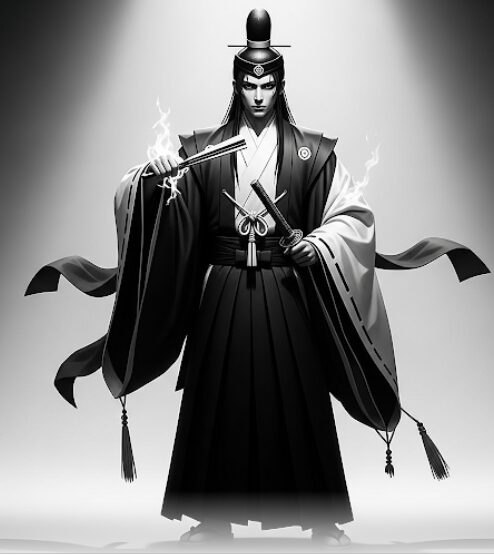
They advised emperors and nobles, especially during the Heian period (794–1185).
The most famous onmyōji is Abe no Seimei, a legendary folklore figure.
Onmyōdō involves rituals, talismans, and calendar-based divination.
It declined in power after the Meiji Restoration, as Japan modernized and banned such practices.
Today, it survives in folklore, shrines, and popular culture.
A combination of geographical isolation, strategic location, autonomous social structures, the demands of the Warring States period(1467-1573), and the integration of traditional skills shaped the emergence of ninja culture in Iga and Koga. These unique regional conditions fostered the development of ninjutsu as a distinct cultural phenomenon.
5-2. What Are the Differences Between Iga-ryu and Koga-ryu?
The primary difference between Iga-ryu and Koga-ryu lies in their operational structure and loyalty.
Koga-ryu ninja often served a specific master or lord.
Iga-ryu ninja prioritized personal expertise and operated with greater independence, working for multiple clients.
Here is a detailed breakdown:
5-2-1. Koga-ryu
Operated as a collective organization of interlinked villages, emphasizing group-oriented activities.
Many Koga ninja were also farmers or samurai, balancing agricultural work during peacetime with ninja duties as needed.
Specializing in group warfare, strategic planning, and psychological tactics, such as using poison, traps, and other tools to disorient enemies.
Mastered herbal medicine and medical practices, developing skills in poison handling and antidotes.
Focused on defensive tactics, misinformation, and neutralizing enemy forces rather than direct combat.
Many Koga ninja served powerful figures like Oda Nobunaga and Tokugawa Ieyasu, maintaining strong political influence. In the Edo period, they were instrumental in espionage for the Tokugawa shogunate.
5-2-2. Iga-ryu
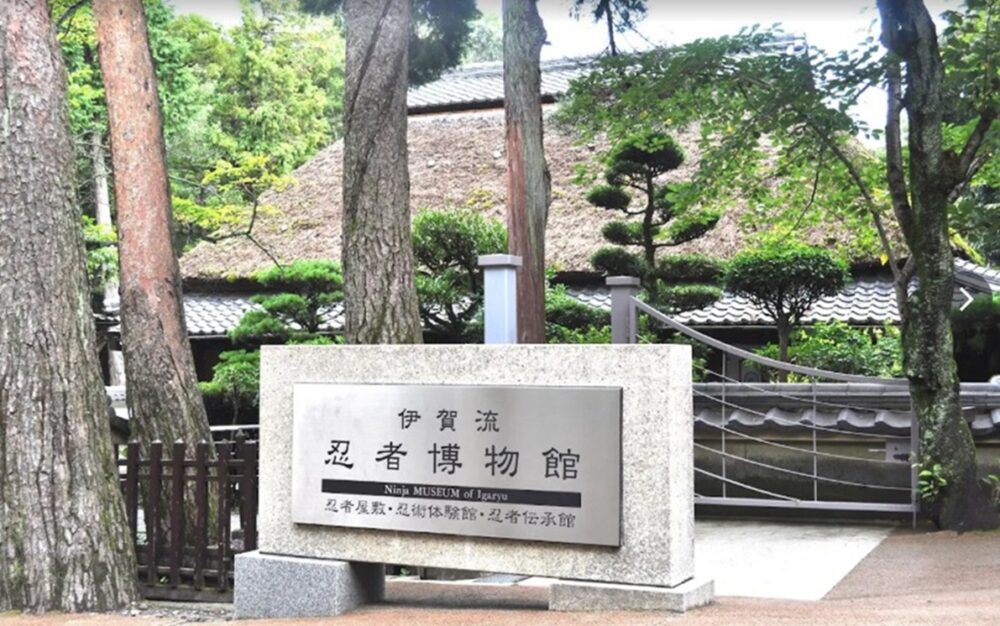
Centered on independent village-level operations with high individual autonomy.
Known for their exceptional specialization in individual skills, such as intelligence-gathering and infiltration.
Although the Iga region suffered devastating attacks from Oda Nobunaga(1534-1582, a leading general) during the Warring States period, surviving ninja later allied with Tokugawa Ieyasu(1543-1616, a founder of the Tokugawa shogunate), contributing significantly to the Edo shogunate’s(1603-1867) intelligence network.
The differences between Iga-ryu and Koga-ryu reflect their distinct approaches to ninjutsu, shaped by their respective histories, social structures, and geographic conditions. While Koga-ryu emphasized collective strength and allegiance, Iga-ryu focused on individual expertise and operational flexibility. Both played critical roles in shaping Japan’s ninja legacy.
6. Ninja Weapons
The weapons used by ninja during the Sengoku period (1467-1573) were diverse and tactically ingenious. Here are some of the main ones.
6-1. Throwing/Disruption
6-1-1. Shuriken
It was a traditional Japanese concealed weapon, typically star-shaped, sometimes stick-shaped, used by ninja for throwing. While often depicted as deadly, they were primarily used to distract or disorient an opponent rather than for lethal force.
6-1-2. Makibishi
They were small, sharp objects scattered on the ground to impede pursuers.
6-2. Assassination/Vital Points
6-2-1. Fukiya
A blowgun, typically used with poisoned darts.
Blowguns are now enjoyed as a sport. They’re good for your health because they incorporate diaphragmatic breathing techniques.
6-2-2. Tekko(fighting gloves) and Kogake (Ashiko) (foot spikes)
6-2-3. Kunai
It was a multi-purpose tool often used for throwing, digging, or climbing. It was a small, practical weapon primarily used for stabbing, climbing, and as a tool, rather than throwing. A cord was threaded through the ring at the end of its handle, making it easier to retrieve. It was a versatile ninja tool, more widely used in infiltration, reconnaissance, and escape missions than in direct combat.
6-3. Combat/Concealable
6-3-1. Ninja-tō
A straight, short sword, often depicted as a ninja’s primary weapon.
6-3-2. Kusarigama
A chain and sickle weapon, offering both long-range and close-quarters combat options.
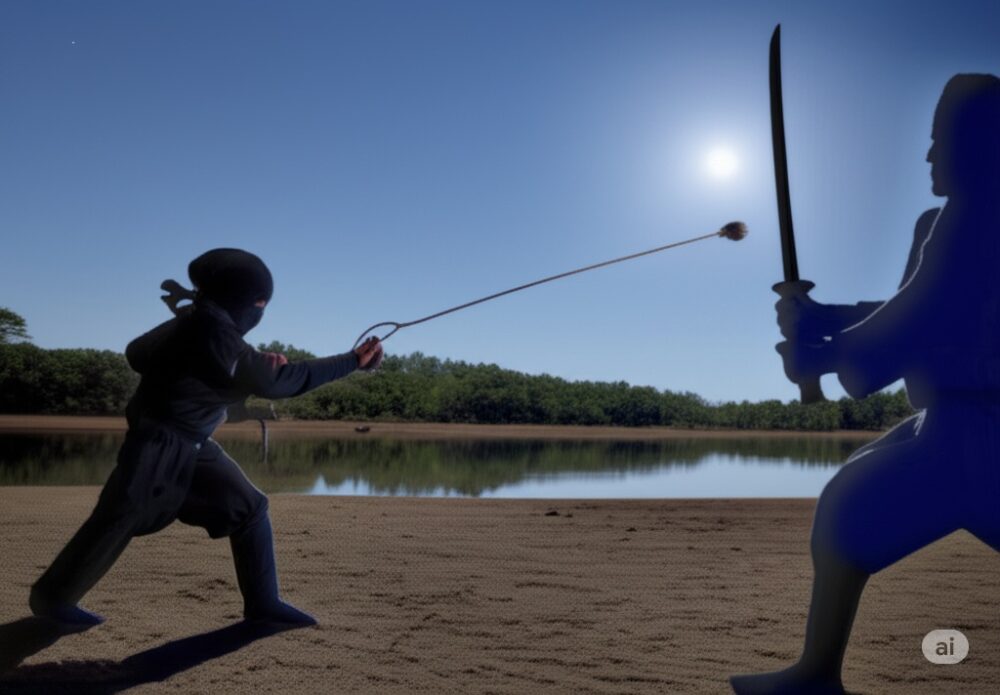
6-3-3. Tekko-kagi
Hand claws or gauntlet claws are used for striking, grappling, or climbing.
6-4. Infiltration/Climbing
6-4-1. Shakujo (concealed weapons)
It is a staff used by Shugendo practitioners for self-defense and to ward off animals. Its head is made of tin (or pewter), and it was also used as a weapon by ninja who disguised themselves as Shugendo practitioners.
Concealed weapons excel at creating the illusion of being unarmed and vulnerable, allowing the user to exploit an opening. This made them the most suitable weapons for ninjas, whose actions were fundamentally based on stealth. The shakujo was a prime example of a concealed weapon.
6-4-2. Kusari-tetsu-kyū
A weighted chain or ball and chain, used for climbing, grappling, or striking.
6-5. Distraction
6-5-1. Kemuridama
Smoke bombs, used for creating a diversion or cover for escape.
7. Ninja Meals
Ninja were very careful about food.
For example, when infiltrating an enemy’s stronghold, their presence might be revealed by the smell of what they had eaten. For this reason, they avoided foods like leeks, onions, and meat. They also refrained from smoking for the same reason.
To remain unscented, ninja cleaned their clothing meticulously and bathed frequently.
It was also believed that eating meat during this time could “muddy” the blood, potentially causing diseases and dulling their sixth sense.
Since they prioritized well-balanced and nutritious meals, they consumed foods low in fat and calories but high in protein. Here is a list of the foods ninja primarily ate.
A ninja’s mission was to accurately deliver critical intelligence from enemy territory to their commander. Therefore, they were instructed to avoid combat whenever possible, commit information to memory with precision, and return without fail.
To fulfill this mission, ninjas required not only calm judgment and agility, but also knowledge of first aid to treat thirst and pain in the mouth and throat, stomachaches, diarrhea, skin irritation, and cuts.
Ninja carried emergency rations specifically designed for such conditions. The following three are considered representative:
7-1. Hyōrōgan (Field Ration Pills)
A fast-acting, functional portable food that rapidly restores stamina. It also nourished, relieved fatigue, soothed pain, promoted relaxation, and addressed wounds or skin problems. These were made by kneading together rice flour, roasted soybean flour, black sesame, sugar, and honey into compact balls.
7-2. Kikatsugan (Endurance Pills)
A long-lasting, stamina-sustaining portable food. Ideal for enduring extended missions, they were made by blending starch with several traditional medicinal herbs.
7-3. Suikatsugan (Thirst-Relief Pills)
Specialized rations for easing mouth pain, dryness, and coughing—designed to alleviate symptoms affecting the mouth and throat.
Ingredients included:
– Umeboshi (pickled plums)
– Rock sugar
– Malt
– Sweet pine bark (for disinfection, blood purification, and a refreshing taste)
-Japanese tea
– Persimmon leaves
– Peach leaves
– Ginger
– Japanese mint (Nihon-hakka) (for disinfection, blood purification, a refreshing taste, and a cooling effect)
– Small amounts of fruit juice
The photo shows modern herbal medicine, but similar natural herbs were believed to have been used in the past.
7-4. Brown Rice and Barley
ninja chose carbohydrate-rich brown rice and barley as their staple foods. They avoided white rice since it led to easier fat accumulation than brown rice.
7-5. Tama
Tama-dasuki was made from dried zuiki (the stalks of taro and similar plants), shaped into small balls. ninja wore them over their shoulders like a sash and would cut, boil, or grill them before eating.
7-6. Black Sugar
Black sugar was consumed for its ability to relieve fatigue.
7-7. Sesame Seeds
Sesame seeds strengthen teeth and bones, enhance hearing and vision, and improve digestion. Ground sesame was more easily absorbed, so ninja sprinkled it over rice.
7-8. Soybeans
Soybeans were a rich source of protein. ninja favored soybean-based foods such as natto and tofu.
7-9. Eggs
ninja frequently ate eggs, especially quail eggs, believing they would improve their skills in uzura-gakure no jutsu, a technique where they curled up like a quail to hide.
7-10. Hoshi-ii (Dried Rice)
Hoshi-ii was steamed rice that had been dried. Ninja softened it by soaking it in water before eating.
7-11. Umeboshi (Pickled Plums)
Ninja regularly ate umeboshi in their daily meals and carried them during missions. Umeboshi helped relieve fatigue and had antibacterial and detoxifying properties.
Dried plums are still a favorite among the Japanese. They are used in nigiri-meshi (rice ball) and rice porridge.
7-12. Sunflower Seeds
Sunflower seeds were small, lightweight, and easy to carry, making them a valuable food source. Their natural oils helped maintain physical endurance.
7-13. Katayaki
Katayaki was a hard, biscuit-like food made by compacting and baking a flour mixture, primarily from brown rice. Originating in the Iga district, it resembled a type of modern senbei (rice cracker) and is still sold today as a souvenir.
Katayaki is a hard cracker sold to tourists in Iga, the “Ninja Town.” You eat it by breaking it with the accompanying tool.
8. Methods of Learning Martial Arts and Espionage Techniques
8-1. Family Education and Secret Transmission
Many ninjas were born into families engaged in the ninja profession and began their training from childhood. Ninjutsu was strictly guarded against external leaks and was passed down only through family and master-disciple relationships. This ensured that knowledge and techniques were preserved within the family lineage.
8-2. Training in Ninjutsu
Ninjutsu was not merely a set of offensive combat techniques but a comprehensive system encompassing survival skills, psychological strategies, and espionage. Key aspects included:
Ninjutsu(Ninja skills) that come in handy during disasters.
8-2-1. Martial Arts (Unarmed and Weapon Techniques)
– Unarmed Combat: Mastery of fighting techniques such as jujutsu(*1), karate, and kenjutsu(fencing).
– Weapon Techniques: Training with shuriken(small throwing blades), ninja swords, bows and arrows, and kusarigama (chain and sickle).
(*1) Classical Japanese martial art, usually referring to fighting without a weapon.
8-2-2. What’s the difference between Judo and Jujutsu?
Jujutsu (or Jiu-Jitsu) is a traditional Japanese martial art used by samurai to defeat armed or armored opponents without weapons.
It includes throws, joint locks, chokes, strikes, and ground fighting techniques.
It was developed for real combat and self-defense in feudal Japan.
Judo, created in 1882 by Jigoro Kano, comes from Jujutsu but focuses more on throws and pins.
Judo removed dangerous techniques to make it safer for practice and sport.
It became an Olympic sport in 1964.
Judo emphasizes physical education, mutual respect, and self-discipline.
So, Jujutsu is older and more focused on self-defense.
Judo is a modern, safer, and widely practiced sport worldwide.
8-2-3. Stealth Techniques
– Disguise and Camouflage: Learning how to blend into the surroundings through attire and behavior.
– Silent Movement: Techniques for walking without making noise and operating effectively at night.
8-2-4. Espionage Techniques
– Cryptography and Secret Codes: Decipher codes using covert language.
– Psychological Tactics and Observation: Methods for gathering intelligence through psychological manipulation and keen observation.
8-2-5. Coexistence with Nature
– Survival Skills and Knowledge of Poisonous Plants: Understanding how to survive in forests and mountains.
– Navigation Using Weather and Stars: Utilizing natural elements for orientation.
8-3. Field Training
Practical training took place in environments simulating real-life scenarios, including:
– Simulated missions in mountains or castle grounds.
– Infiltration and escape exercises in enemy territory.
8-4. Learning from Other Schools and External Knowledge
Ninja demonstrated flexibility by adopting martial arts and tactics from other regions and countries. During the Warring States period(1467-1568), there are records of ninja secretly traveling abroad to learn foreign techniques.
8-5. Guidance from a Master
Training was often conducted under the direct guidance of a master, who not only taught techniques but also instilled the mindset required of a ninja. This included crisis management skills and mental resilience.
Ninja training was rigorous and required years of discipline. The skills they mastered were not solely for direct combat but were primarily aimed at the success of espionage and covert operations.
9. Ninja Memory Techniques
As ninja is often compared to spy, their primary mission was intelligence gathering. In an era without cameras or recording devices, they could not afford to take notes freely. Carrying written documents was risky—if they were discovered, their mission could be compromised. Therefore, ninja developed various techniques to memorize information.
9-1. Associative Method
This method involves replacing the information to be remembered with something else.
For example, when gathering intelligence on enemy troop strength, precise numbers needed to be memorized. To achieve this, ninja would convert numbers into other representations, making them easier to recall accurately.
9-2. The Art of “Fubō” (Never Forgetting)
For extremely critical information, ninja employed a technique called “fubō no jutsu”—the “Art of Never Forgetting.”
This method involved inflicting a wound on their own body using a blade or another sharp object. Though painful, the scar served as a powerful trigger, vividly recalling the memory associated with it. This ensured that vital information would never be forgotten.
This technique exemplifies the ninja’s unwavering commitment to their mission. Their willingness to endure pain for the sake of intelligence transmission highlights the extreme dedication required in their craft.
10. Ninja’s Basic Physical Training Methods
Ninja needed to develop their basic physical abilities, such as leg strength and jumping power, far beyond those of ordinary people. To achieve this, they engaged in various unique training methods to enhance their fundamental skills.
10-1. Running Ability
Running speed was essential for escaping quickly when pursued by enemies. Since measuring time accurately was difficult in those days, the ninja developed unique training methods.
One method involved running while ensuring that a long piece of cloth trailing behind them or a Japanese hat pressed against their chest did not fall to the ground.
Since stopwatches did not exist then, this method allowed ninja to gauge their speed effectively, making it a practical training technique.
10-2. Stealthy Walking (Shinobi-Ashi)
Shinobi-ashi, or stealth walking, mimics the movements of a cat. This technique was crucial for infiltrating enemy territory while making as little noise as possible. There were no specific methods other than listening to passed-down knowledge and relentlessly practicing to walk as quietly as possible.
10-3. Jumping Ability
Jumping power was a vital skill for ninja, and it was necessary for traversing difficult terrain and leaping over fences or obstacles.
One well-known training method involved planting hemp【photo】, a plant that grows rapidly, and jumping over it daily. Since hemp grows approximately 2–3 cm each day, this method naturally increases the training difficulty over time, making it both an ideal and highly effective practice.
10-4. Eyesight
Along with leg strength and jumping ability, good eyesight was another crucial trait for a ninja. Superior vision allowed them to spot enemies from a distance, enhancing their survival and information-gathering skills. Additionally, their work required them to see well in the dark.
To improve night vision, the ninja repeatedly moved between bright and dark environments. This constant adjustment caused the pupils to expand and contract, strengthening the eye muscles. Over time, this training enabled them to quickly adapt to sudden darkness and see clearly in dimly lit areas.
10-5. Hearing Ability
Hearing was particularly essential for intelligence-gathering missions. It is said that ninja could distinguish words even when enemies spoke in hushed voices.
One specific training method is a saotokiki, a skill for perceiving subtle sounds. In a silent environment, a needle was dropped onto a whetstone, and the ninja would train to recognize the tiny sound it made.
This practice was performed in pairs—one person dropped the needle while the other listened. Over time, the listener increased their distance from the whetstone to improve their ability to detect faint noises from afar.
Advanced training even involved dropping multiple needles simultaneously, requiring the ninja to identify the exact number of falling needles based on sound alone.
10-6. Beyond Physical Training
Through the rigorous training methods mentioned above, ninja honed their physical abilities to an extraordinary level. However, other skills were also essential, such as keen insight and a strong memory. Ninja trained themselves daily through theoretical study, field exercises, and specialized mnemonic techniques unique to their craft.
These unique and intensive training methods enabled ninjas to develop abilities far beyond those of ordinary people.
11. Disguisement
When ninja infiltrated enemy territory, they disguised themselves to conceal their identity and purpose.
There were seven types of disguises(shichihoude) as follows;
11-1. Komusō
Komusō refers to mendicant monks known for their distinctive straw basket hats and bamboo flutes.
11-2. Shukke
Shukke denotes monks who renounce worldly life to devote themselves to Buddhist practice.
11-3. Yamabushi
Yamabushi are practitioners of shugendō, a spiritual tradition that views mountains as sacred. They roam the hills, worshiping natural elements such as trees and rocks, which are believed to house divine spirits. They seek to enhance their abilities and unlock human potential through rigorous training.
11-4. Shōnin
Shōnin refers to traveling merchants.
11-5. Hokashi
Hokashi were street performers who specialized in hoka—a form of street entertainment popular from the medieval to early modern periods.
11-6. Sarugakushi
Sarugakushi were performers of sarugaku, an early theatrical art that later evolved into Nō and Kyōgen. During the Heian period(794-1185), sarugaku featured acrobatics, magic tricks, and comedic mimicry.
11-7. Tsuneno-katachi
Tsuneno-katachi refers to peasants and samurai.
These disguises were collectively referred to as shichihō-idetachi-no-koto or shichige in ninja manuals.
12. The Execution Date of a Mission and Sleep
Ninja extensively studied the best days for their missions and the nature of human sleep. By choosing nights without moonlight or times when people were in deep sleep, they could achieve their objectives without being detected.
To determine whether an enemy was in deep sleep, they used a kikizutsu tube (a sound collector made of bamboo) to listen to their breathing. Ninja also slept with their hearts (the left side of their bodies) facing downward so that they had a better chance of surviving in case of a sudden attack.
13. Five Famous Escape Techniques
The following five escape techniques were well known:
13-1. Katon
(written with the kanji for “fire” and “escape”) – Using fire or gunpowder to create confusion and flee. Ninja employed the following weapons:
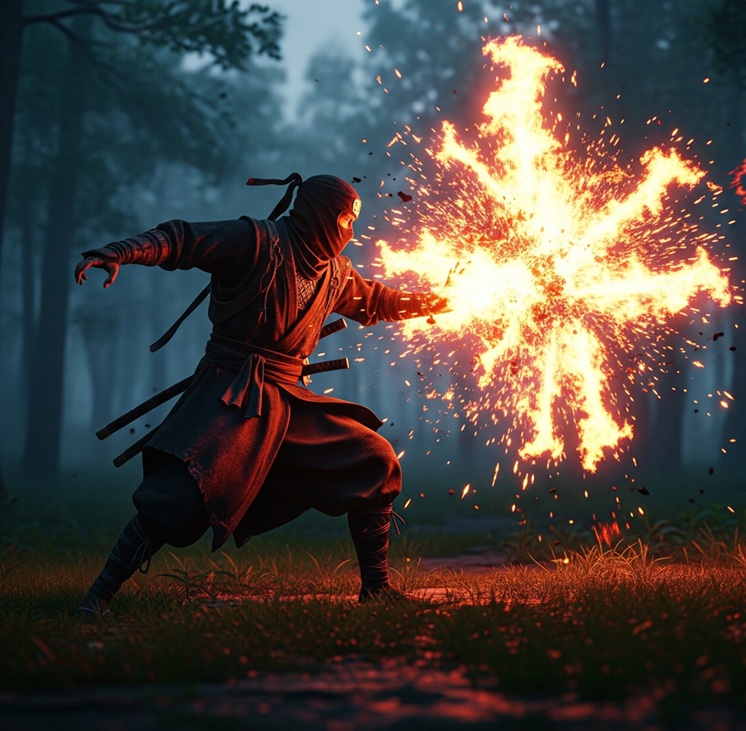
This is an image illustration. It shows how fire or gunpowder is used to distract or confuse the enemy, allowing for an escape while concealing one’s movements.
- Houribiya: Arrows similar to hand-thrown explosives.
- Uzumebi: A wooden box filled with gunpowder, buried in the ground. It functioned like a landmine, exploding when stepped on.
- Hyakuraiju: Fireworks similar to firecrackers, producing a continuous series of loud explosions.
13-2. Suiton
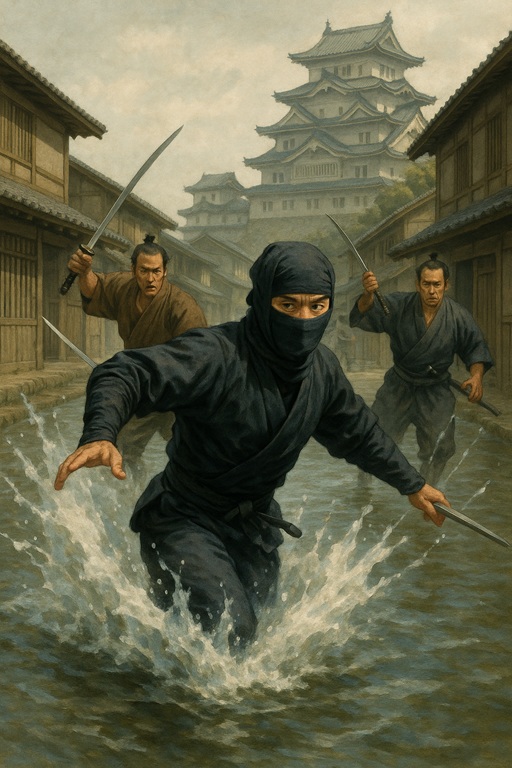
This is an illustrative image. In reality, when pursued by enemies near ponds or lakes, one would hide underwater and breathe through a straw or similar object.
(written with the kanji for “water” and “escape”) – Hiding underwater to evade enemies.
13-3. Enton
(written with the kanji for “smoke” and “escape”) – Using kemuridama (smoke bombs) to create a smokescreen. Kemuridama were spherical containers made of hardened paper, filled with gunpowder, and fitted with a fuse. When ignited, they produced an explosion and a thick cloud of smoke to disorient opponents.
13-4. Kinton
(written with the kanji for “iron/money” and “escape”) – The only technique among the five that lacked a unified meaning. It involved various tactics, such as:
- Using makibishi (caltrops) and shuriken (throwing stars) made of iron.
- Striking a fire alarm bell repeatedly creates a distraction.
- Flashing a naked sword blade to intimidate enemies.
- Offering money as a bribe to escape.
Despite its varied methods, all these tactics were collectively called Kinton no jutsu.
13-5. Ongyo
(written with thekanji for “hiding behind objects”) – Camouflaging oneself in the surroundings, such as:
- Hiding in bushes (Konoha-gakure).
- Concealing oneself behind objects (Kan-non-gakure).
- Mimicking a rock (Uzura-gakure).
14. Female Ninja
In works of fiction since the 1960s, female ninja have come to be called kunoichi. This term is derived from breaking down the kanji for “woman” (女) into three components, which, when read in a Japanese style, form the sounds ku, no, and ichi.
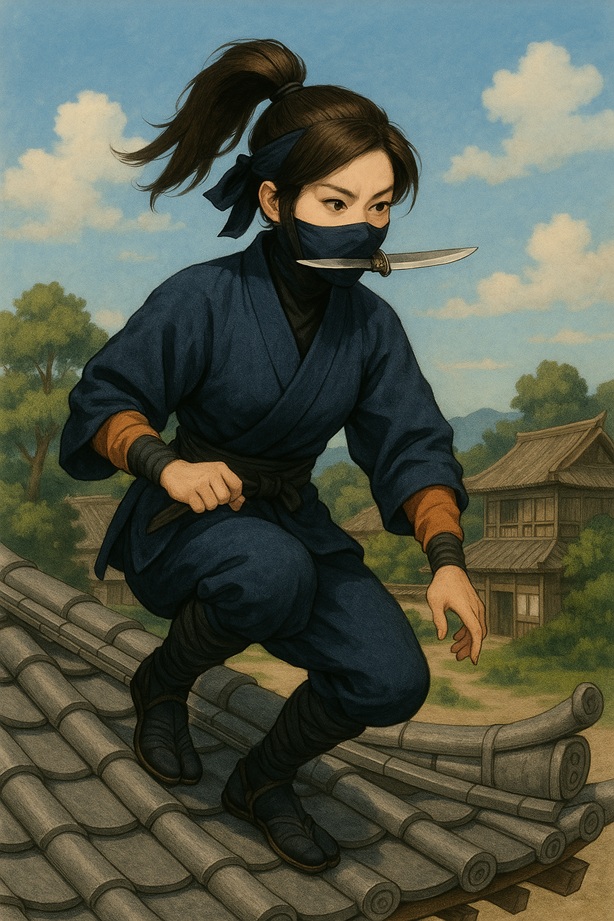
This kind of female ninja image was devised only recently, mainly through novels and other media.
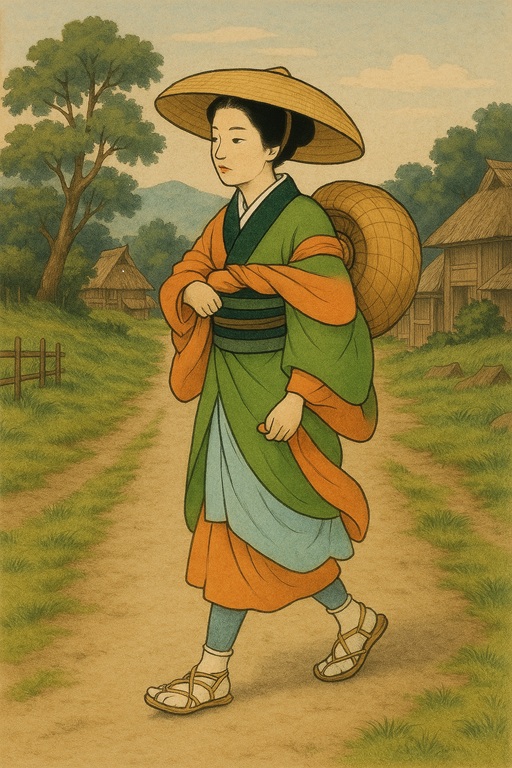
If there had been female ninjas, they probably would not have dressed in a ninja-like manner as shown in the photo above in their daily lives. Even as ninjas, when traveling to a mission site, they likely would have dressed like ordinary women of the time on a journey—just as depicted in this image.
According to Professor Yuji Yamada of Mie University and Professor Katsuya Yoshimaru of Nishogakusha University, there are no historical records confirming the existence of female ninja who engaged in espionage or sabotage in the same way as male ninja. However, women did likely operate as ninja, and their presence has attracted attention as part of history. Many stories about female ninja are more influenced by Edo-period(1603-1868) novels, theater, and modern fiction rather than strict historical records.
14-1. Roles and Characteristics of Female Ninja
Like their male counterparts, female ninja carried out missions such as intelligence gathering, infiltration, and assassination. However, they had distinct roles and strategies unique to their gender.
14-2. Traits and Roles of Female Ninja
14-2-1 Espionage and Infiltration
Female ninja took advantage of the fact that women were less likely to be suspected, allowing them to infiltrate the estates of aristocrats and samurai as maids, geisha, or courtesans. They excelled at extracting confidential information through conversations at banquets and social gatherings.
14-2-2. Disguise and Psychological Manipulation
Female ninja mastered the arts of disguise and makeup, enabling them to lower their targets’ guard. They also practiced psychological manipulation to naturally extract information from their targets. Some even employed seduction tactics, similar to what is now known as a “honey trap.”
14-2-3. Assassination and Use of Poison
Female ninja sometimes carried out assassinations using poisons or small concealed weapons such as hairpins or daggers. They were particularly skilled in preparing and administering poison.
14-2-4. Training in Ninjutsu
Like male ninja, female ninja underwent training in martial arts and ninjutsu. However, their techniques often prioritized agility and quick thinking over brute strength.
This was based on a diverse and unique system of education and training. While the specifics varied depending on the ninja’s place of origin, school, and assigned role, the following elements were commonly included:
15. Real-Life Ninja in Japan
Several historical figures are known to have been real ninja. They engaged in a wide range of activities, including espionage, sabotage, message delivery, and personal protection. Far from being mere “assassins” or “superhumans,” they carried out practical and realistic missions, especially during the Sengoku period (1468–1568) and the Edo period (1603–1868). Below are some of the most well-known real ninja and a summary of their activities.
15-1. Momochi Sandayu
Period: Sengoku period(1467-1573)
Affiliation: Iga school
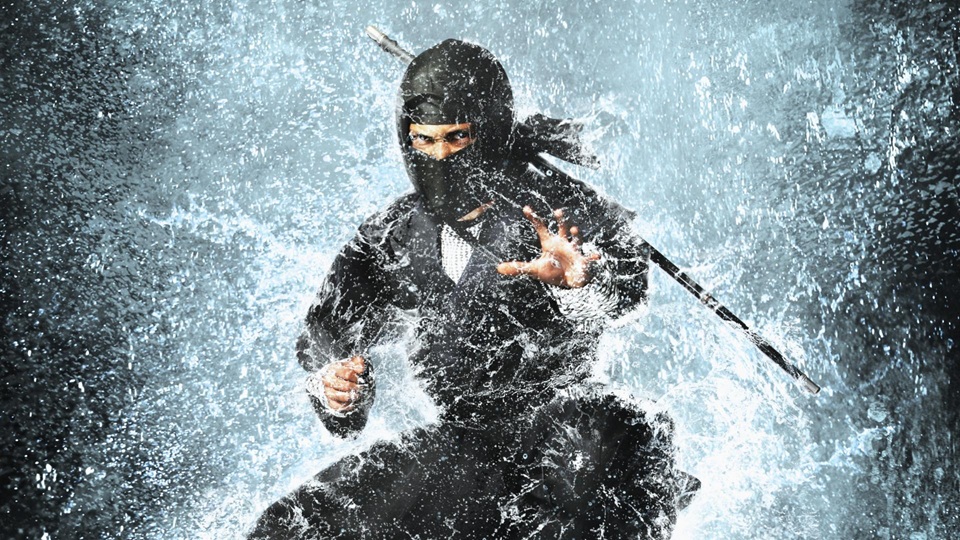
Overview:
He is considered one of the prominent leaders of the Iga ninja group known as the “Iga-shu.”
Activities:
He fought against Oda Nobunaga (1534–1582) during Nobunaga’s invasion of Iga (Tenshō Iga War, 1581), but was defeated.
Later, he is said to have helped consolidate the Iga ninja and pave the way for their service under the Tokugawa clan.
15-2. Hattori Hanzo Masanari
Period: Sengoku to Azuchi-Momoyama period(1467-1590)
Affiliation: Iga school
Overview:
He was a ninja and samurai from Iga who served Tokugawa Ieyasu (1543–1616). He is one of the most famous ninja in history.
Activities:
During the famous “Iga Crossing,” Hanzo protected Tokugawa Ieyasu’s party and led them safely through Iga and Kōga back to Mikawa.
This crossing was a dramatic escape by Ieyasu from Sakai (south of Osaka) back to his domain in Mikawa after the death of Oda Nobunaga at the Honnōji Incident.
Hanzo was not only a ninja but also an active samurai. His name lives on in places such as Hanzōmon Gate in the Imperial Palace and Tokyo’s Hanzomon subway line.
15-3. Fujibayashi Nagatonokami
Period: Sengoku period(1467-1573)
Affiliation: Iga school
Overview:
He is believed to have contributed to the compilation of the Bansenshukai, a famous ninja manual from the Iga school.
Activities:
Although not known for battlefield action, he played an important role in developing and preserving the theory and documentation of ninjutsu.
The Fujibayashi family is considered the scholarly lineage of Iga-style ninjutsu(fighting art of the ninja).
15-4. Shimotsuge no Kozaru
Period: Sengoku period(1467-1573)
Affiliation: Iga or Kōga
Overview:
The name “Kozaru” (Little Monkey) was a nickname given to particularly agile ninja.
Activities:
He is said to have undertaken special missions such as infiltrations, arson, poisoning, and intelligence gathering.
His existence is recorded in limited sources, and much of his story is considered legendary.
15-5. Mochizuki Rokurō
Period: Sengoku period(1467-1573)
Affiliation: Kōga school
Overview:
A member of the Mochizuki family, one of the Kōga 53 Clans. He is said to have engaged in espionage for both Oda Nobunaga and Tokugawa Ieyasu.
(*) In 1487, a prolonged conflict between the influential Kōga leaders allied with the Sasaki Rokkaku clan and the Ashikaga shogunate lasted nearly three years.
Though the Rokkaku clan survived, the Kōga warriors’ guerrilla tactics and combat prowess earned them fame throughout the country.
The local warriors who participated in that campaign later became known as the “Kōga 53 Clans.” They continued their intelligence and combat operations under the Rokkaku until Oda Nobunaga took control of the region.
Activities:
He is known for activities such as intelligence gathering and delivering secret messages, serving as a typical example of Kōga-style ninja operations.
Long ago, ninja were active all across Japan. Japanese people have a deep affection for ninja. If you visit somewhere in Japan, you might have a wonderful encounter by checking out souvenir shops or exploring ninja-related tourist spots and attractions.
Here, I will introduce popular ninja-themed destinations and facilities that every Japanese person knows.
16-1. International Ninja Research Center (Mie Prefecture)
The system of Regional Satellites is aimed to supply the practical application of the results of educational activities and research conducted in Mie University, thus playing a role in the revitalization of the regions. That’s why the Satellites carry on versatile activities regarding the whole territory of Mie Prefecture as a field for education activities and research.
16-2. The International Ninja Research Association (Mie Prefecture)
The Association is a scholarly association created for gathering different researchers, representatives of ninja-related business, municipalities and the wide range of individuals interested in the phenomenon of ninja, for doing international and interdisciplinary research of ninja-related subjects, sharing information with each other, communicating and developing friendly relations among members.
16-3. Ninja Museum of Igaryu (Mie Prefecture)
The Iga-ryu Ninja Museum traces its origins to the Iga-ryu Ninja House, which opened in 1998 and was renovated and reopened as the Iga-ryu Ninja Museum. Then, in 2008, it became the only museum in Japan themed around ninja and ninjutsu to be officially
designated as a registered museum under the Museum Act. In addition to focusing on the Iga and Koga ninja traditions, the museum houses approximately 1,000 historical documents and
artifacts related to ninja and ninjutsu from across Japan. As part of the Japan Heritage(*) site
“The Homeland of Ninja – Iga,” the museum continues to engage in activities that help
deepen public understanding of the ninja and their practices.
16-4. Koga Ninja Village (Shiga Prefecture)
During the Sengoku period, there were ninja who operated in secret and played a hidden role in shaping history. Among them, the “Iga-ryu” and “Koga-ryu” are known as Japan’s most prominent ninja clans. The regions of Iga (in Mie Prefecture) and Koga (in Shiga Prefecture), where their legacy remains strong, are considered the true birthplaces of the ninja.
Here, we introduce the appeal of “The Homeland of Ninja – Iga and Koga,” which has been recognized as a Japanese Heritage(*) site. Why not step into the world of the ninja by visiting historical sites such as authentic ninja houses, castle ruins where ninja were active, and shrines and temples that served as training grounds? You can experience the rich history of the ninja firsthand.
(*) Japan Heritage is a program launched by Japan’s Agency for Cultural Affairs in 2015. It
designates stories that showcase the cultural traditions and history of a region. These stories
are told through local historical sites, landscapes, and customs. The goal is to promote regional revitalization and attract tourism. Each Japan Heritage site tells a unique narrative of
Japan’s identity and legacy.
16-5. Ninja Experience Cafe Tokyo Harajuku
It is located along Takeshita-dori Avenue, in the heart of Harajuku’s sightseeing district,
making it very easy to access!
Inside, you’ll find ninja house-style tricks. A rolling door leads to a hidden room where you
can leap out from behind a hanging scroll and take down your enemies with a single strike!
Don’t forget to strike a cool pose and take a photo with the bright red balustrade.
We also highly recommend the “Walking Option,” which lets you stroll along Takeshita-dori in
a ninja costume and take photos around the Harajuku area.
This ninja café has sister locations in Asakusa, Tokyo; Dotonbori, Osaka; and Gion, Kyoto, in
addition to its original location here in Harajuku, Tokyo.
16-6. Ninja Trick House in Tokyo
This facility is an interactive ninja trick house located in the heart of Tokyo. It features a
traditional Japanese-style room displaying Japanese swords and ninja blades, as well as an
authentic ninja training hall. Despite being in the city center, the atmosphere feels just like a
real ninja house. Visitors can enjoy a variety of ninja-themed attractions, including shuriken
throwing, swordplay experiences, and finding hidden tricks. You can also take
commemorative photos with a ninja.
16-7. Ninja Weapon Museum (Kanazawa City)
A tourist spot that people of all ages can enjoy!
This museum, located in the Nishi Chaya District of Kanazawa City (*), showcases and introduces ninja-related weapons. Inside, you’ll find approximately 160 items across 50 types on display, including shuriken, chain weapons, and suits of armor. There’s also a hands-on Shuriken Throwing Experience area that children can enjoy.
You’ll find replica swords, exclusive museum merchandise, and local Kanazawa specialties such as traditional sweets and ceramics at the souvenir shop.
A tourist spot that people of all ages can enjoy!
(*) 2 hours 56 minutes by Hokuriku Shinkansen from Tokyo Station, 13,850 JPY.
Thank you so much for your reading.

